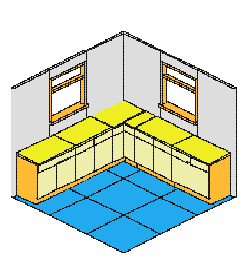Kitchen Surfaces
From DT Online
Floors and walls need special thought when planning a kitchen. Floors need to be easily cleaned, non-slippery and also comfortable and quiet to walk on. Walls should be easy to wipe clean and in areas behind taps, tiled or laminate splashbacks are needed.
Before covering, concrete floors should be checked that they are sound. Slight unevenness can be cured by using a self-levelling compound. Wooden floors should be checked for rot, loose boards fixed, and protruding nails and screws removed. Uneven floors should first be covered with a layer of hardboard, rough side up, or Chipboard if ceramic tiles are to be used to cover it.
Concrete floors can be painted and wooden floors sanded and sealed but more usually one of the following coverings is used:
Vinyl floor covering or cushioned vinyl - this is still often referred to as linoleum or lino. It comes in a range of patterns and colours and in 2m, 3m and 4m widths off the roll. The patterns are printed underneath a thin transparent PVC layer.
Cork tiles - these can be used on floors and walls; dense tiles are best for floors. Some have a surface layer of transparent vinyl.
Clay/ceramic tiles - there are two types: clay floor quarries and ceramic floor tiles. Ceramics are made to a closer tolerance, have a smoother finish, are glazed and absorb less water.
